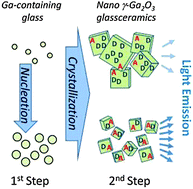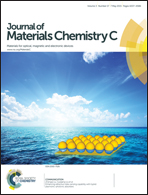Nucleation-controlled vacancy formation in light-emitting wide-band-gap oxide nanocrystals in glass
Abstract
Light emission of nanocrystals (NCs) can depend not only on NC size but also – and even more importantly in wide-band-gap NCs – on the occurrence of optically active sites, such as donor–acceptor pairs (DAPs). Here, we demonstrate that controlling the thermo-chemical conditions of NC nucleation when NCs are forming in a solid host – an approach often used for driving NC size dispersion – can be an innovative strategy for tailoring DAP population. Our data show that light emission from DAP recombination and decay in defect sites can be controlled in γ-Ga2O3 NCs in alkali-germanosilicate glass – a prototypal oxide-in-oxide nanostructured system – by oxygen and gallium vacancy formation during nucleation. Time-resolved UV-excited photoluminescence, combined with differential scanning calorimetry, X-ray diffraction, and transmission electron microscopy, reveal how nucleation pretreatment determines, besides NC size and concentration, also the DAP number via promotion of acceptor formation or their passivation during interaction with the host. The results envisage the possibility of nucleation-based design of light-emitting NCs in a wide range of oxide systems.


 Please wait while we load your content...
Please wait while we load your content...